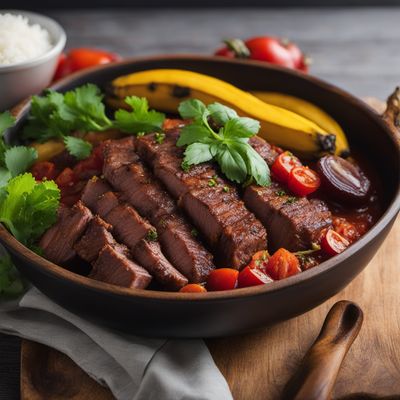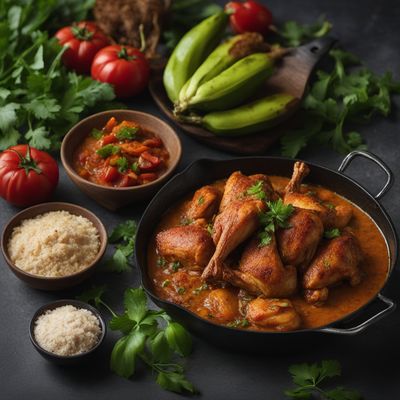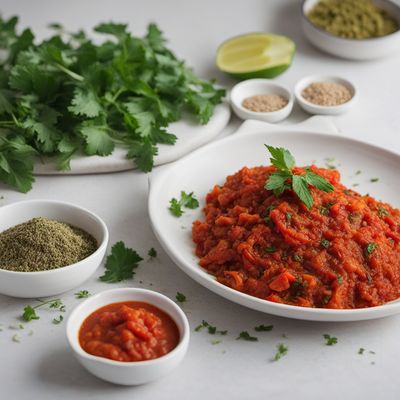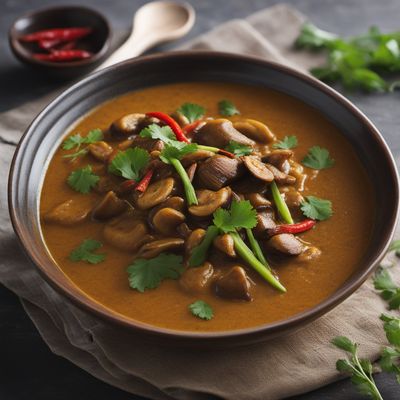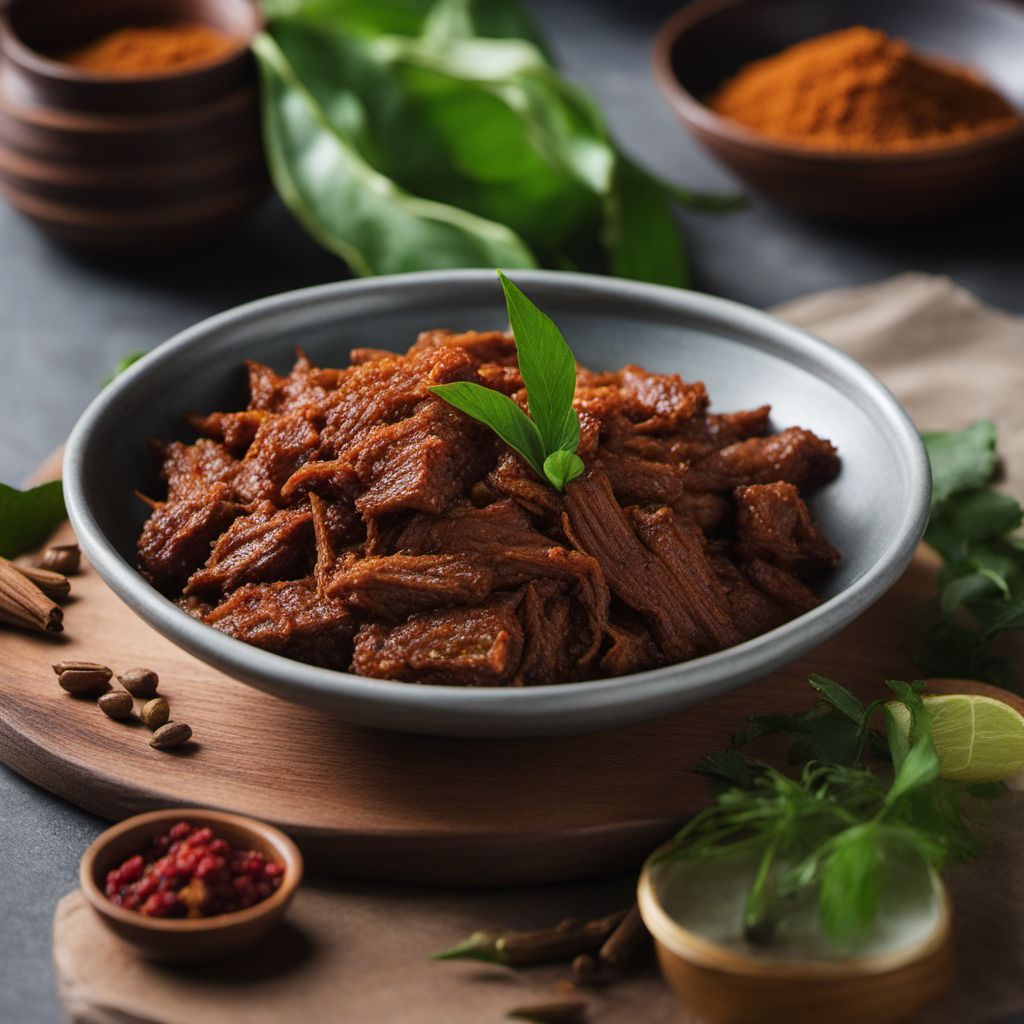
Recipe
Malaysian Chinese-style Beef Rendang
Spicy and Fragrant Beef Rendang with a Malaysian Twist
4.4 out of 5
Indulge in the rich and aromatic flavors of Malaysian Chinese cuisine with this tantalizing Beef Rendang recipe. Slow-cooked to perfection, this dish combines tender beef with a harmonious blend of spices and coconut milk, resulting in a mouthwatering and satisfying meal.
Metadata
Preparation time
20 minutes
Cooking time
2-3 hours
Total time
2 hours 20 minutes - 3 hours 20 minutes
Yields
4 servings
Preparation difficulty
Medium
Suitable for
Halal, Gluten-free, Dairy-free, Nut-free, Low carb
Allergens
N/A
Not suitable for
Vegan, Vegetarian, Paleo, Keto, Pescatarian
Ingredients
This adaptation of the original Congolese Liboké de viande incorporates the distinct flavors and cooking techniques of Malaysian Chinese cuisine. The original dish is typically cooked with African spices and ingredients, while the Malaysian Chinese version uses a blend of lemongrass, galangal, and other spices commonly found in Malaysian cuisine. Additionally, the original dish may not include coconut milk, which is a key ingredient in Malaysian Chinese-style Beef Rendang, adding a creamy and rich element to the dish. We alse have the original recipe for Liboké de viande, so you can check it out.
-
1 kg (2.2 lbs) beef, cut into cubes 1 kg (2.2 lbs) beef, cut into cubes
-
4 stalks lemongrass, bruised 4 stalks lemongrass, bruised
-
4 slices galangal 4 slices galangal
-
4 kaffir lime leaves 4 kaffir lime leaves
-
400 ml (13.5 fl oz) coconut milk 400 ml (13.5 fl oz) coconut milk
-
2 tablespoons vegetable oil 2 tablespoons vegetable oil
-
2 tablespoons tamarind paste 2 tablespoons tamarind paste
-
2 tablespoons palm sugar 2 tablespoons palm sugar
-
1 cinnamon stick 1 cinnamon stick
-
4 cloves 4 cloves
-
4 cardamom pods 4 cardamom pods
-
2 star anise 2 star anise
-
1 teaspoon turmeric powder 1 teaspoon turmeric powder
-
1 teaspoon chili powder 1 teaspoon chili powder
-
Salt, to taste Salt, to taste
Nutrition
- Calories (kcal / KJ): 450 kcal / 1884 KJ
- Fat (total, saturated): 30g, 20g
- Carbohydrates (total, sugars): 10g, 5g
- Protein: 35g
- Fiber: 2g
- Salt: 1.5g
Preparation
-
1.Heat the vegetable oil in a large pot over medium heat.
-
2.Add the lemongrass, galangal, kaffir lime leaves, cinnamon stick, cloves, cardamom pods, and star anise. Sauté for a few minutes until fragrant.
-
3.Add the beef cubes to the pot and cook until browned on all sides.
-
4.In a separate bowl, mix together the turmeric powder, chili powder, tamarind paste, palm sugar, and salt. Add this mixture to the pot and stir well to coat the beef.
-
5.Pour in the coconut milk and bring the mixture to a simmer. Reduce the heat to low and cover the pot.
-
6.Allow the beef to simmer for 2-3 hours, stirring occasionally, until the meat is tender and the sauce has thickened.
-
7.Adjust the seasoning with salt if needed.
-
8.Serve the Malaysian Chinese-style Beef Rendang hot with steamed rice or roti.
Treat your ingredients with care...
- Lemongrass — Bruise the lemongrass stalks by lightly pounding them with a rolling pin or the back of a knife to release their aromatic oils.
- Galangal — If fresh galangal is not available, you can use dried galangal powder as a substitute. Use half the amount of dried galangal powder compared to fresh galangal.
- Kaffir lime leaves — If fresh kaffir lime leaves are not available, you can use dried kaffir lime leaves. Use half the amount of dried leaves compared to fresh leaves.
- Tamarind paste — Soak tamarind pulp in warm water for 10 minutes, then strain to obtain tamarind paste.
- Palm sugar — If palm sugar is not available, you can substitute it with brown sugar or coconut sugar.
Tips & Tricks
- For an extra depth of flavor, marinate the beef cubes with the spice mixture for a few hours or overnight before cooking.
- If you prefer a spicier rendang, increase the amount of chili powder or add fresh chili peppers.
- Allow the rendang to simmer slowly over low heat to ensure the beef becomes tender and the flavors develop fully.
- Leftover rendang tastes even better the next day as the flavors continue to meld together.
- Serve the rendang with a side of cucumber slices or pickled vegetables to balance the richness of the dish.
Serving advice
Serve the Malaysian Chinese-style Beef Rendang hot with steamed rice or roti. Garnish with fresh cilantro leaves for a pop of color and freshness.
Presentation advice
Present the Beef Rendang in a shallow serving dish, allowing the rich and thick sauce to envelop the tender beef. Sprinkle some toasted coconut flakes on top for an added touch of texture and visual appeal.
More recipes...
For Liboké de viande
For Congolese cuisine » Browse all
More Congolese cuisine dishes » Browse all

Maboké
Fish in cassava leaves
Maboké is a traditional Congolese dish that is made with cassava leaves and peanut butter. It is a hearty and flavorful dish that is perfect for a...

Liboké de viande
Meat in plantain leaves
Liboké de viande is a traditional African dish that is perfect for a family dinner or a special occasion. It is a flavorful and aromatic dish that...

Poulet nyembwe
Poulet nyembwe is a traditional Congolese dish that features tender chicken in a rich and spicy peanut sauce. The dish is typically served with...
